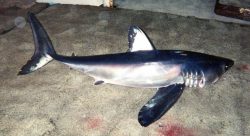select your film:


The Longfin Mako Shark is found globally in temperate and tropical waters. The extent of the population and their range is somewhat uncertain due to the fact Longfin Makos are often misidentified as Shortfin Makos, which outnumber Longfins 1000 fold in fishery landings. They are categorised as Vulnerable by the ICUN as a precautionary measure.
Longfin Mako Sharks are usually found in open water, at depths between 50 and 220 metres, depending on the location. They have a long slim body and large pectoral fins, from which they derive their name. The average length is around 2.5m, though the largest ever reported was a female measuring 4.3m. In terms of size, they are second only to Great White sharks in the Lamnidae family.
Their only natural predator is the Orca whale, though smaller Longfins sometimes fall prey to other sharks. They are at risk from humans, however, as their large jaws are highly prized. Longfin Makos are generally not sought after for their meat as it has a mushy texture, though it is impossible to know how many are finned at sea and then thrown back, as these individuals are not recorded in landing data.
In Longfin Makos, reproduction is ovoviviparous, meaning that eggs hatch inside the mother but the pups remain in utero until they are fully developed and ready to be born. Pups are usually born in the winter and females to swim to warmer, shallower waters to give birth. They usually produce two pups at a time, one in each uterus. At birth, pups measure between 97 and 120cm.
It is not known whether the Longfin Mako is endothermic (warm-blooded), like its close relatives the Great White and the Shortfin Mako.
Do you have images or videos of Longfin Mako Sharks?
Submit them to [email protected].
